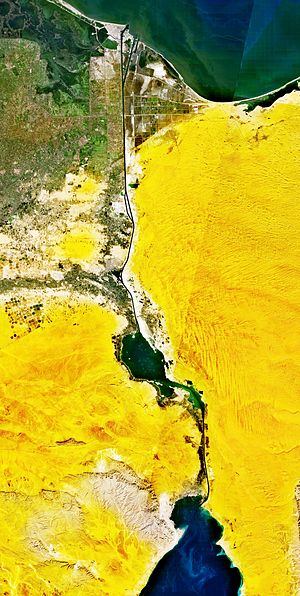A Look at Dr. José Rizal's Diary: The Timeless Tragedy of the Suez Canal, Egypt, then and now.
On 2nd June 1882, Dr. José Rizal was aboard the steam ship Djemnah on his way to Marseilles, France via the Suez Canal.
On 2nd June 1882, Dr. José Rizal was aboard the steam ship Djemnah on his way to Marseilles, France via the Suez Canal.
 |
| Aden, Yemen on the Red Sea |
 Image via Wikipedia Image via Wikipedia |
| Rizal described the lakes on the Suez Canal. |
Looking at a satellite map today, we can clearly see what Rizal was writing about when he wrote: "The Canal, which opened in the middle of a dessert of sand and stone, is 85 kilometers long and perhaps 80 varas wide." I believe in the reliability of Rizal's land estimates and measure. While a student at the Ateneo Municipal in Manila, in 1881, he studied and earned a Land Surveyor's license. Apparently Paciano had asked him to survey the parcel of land belonging to the family..
Rizal continues with his description of the Canal. "It is not straight throughout its length; it has curves but small ones; sometimes it flows into a lake; where it is narrowest it is believed Moses passed though while wandering in the desert. It crosses three lakes in its course. On both banks. which are all yellow and white; where it is a real jewel to find grass, are erected some telephone stations at regular intervals."
From Suez Canal, Dr. José Rizal embarks and lands in Port Said, a cosmopolitan city that straddles Africa and Europe. He noted with interest the various members of several nationalities who lived in that city.
Today, I hope that the Egyptian contemporary political situation stabilizes because in July of this year, 2011, I will be tracing the footsteps of Dr. José Rizal as he entered through the Suez Canal to Port Said. I already booked my flight and I'll be sure to get a fairly good grasp of what Dr. José Rizal saw then in the 19th century (1882) and what he would have observed had he arrived now in the 21st century (2011).

2 comments:
good luck on your trip to suez canal and retracing the footsteps of Jose Rizal.
HI Ige: Have you seen my recent Suez Canal blog? It is in another site. Please see: http://penelopevflores.blgspot.com.
It was a most exhilarating trip and most adventurous since we encountered the Arab Spring riots in Cairo which brought down the Mubarak regime, at the same time we were there. Enjoy the blog, and please keep sending me your precious feedback.
Salamat.
Penelope
Post a Comment